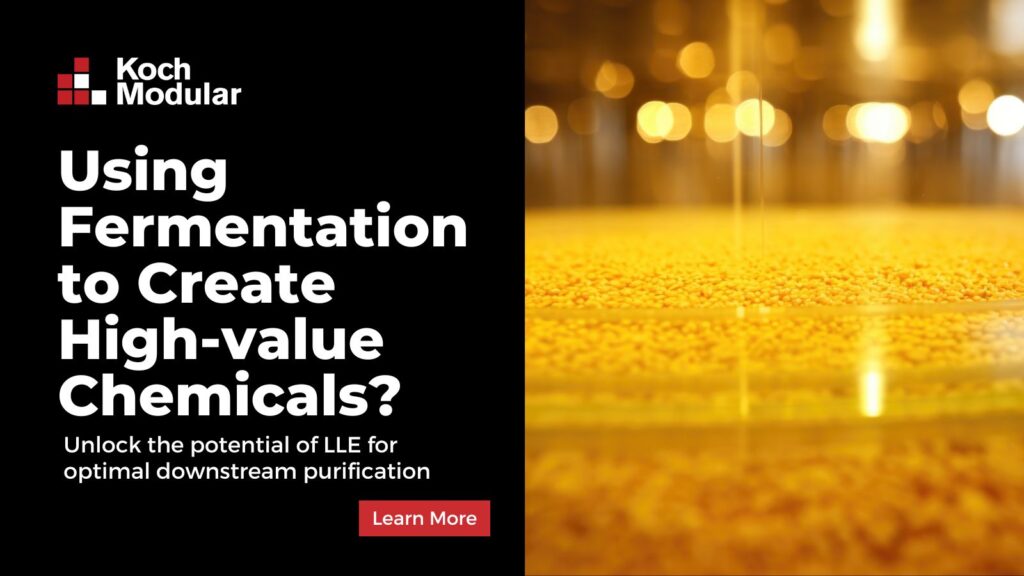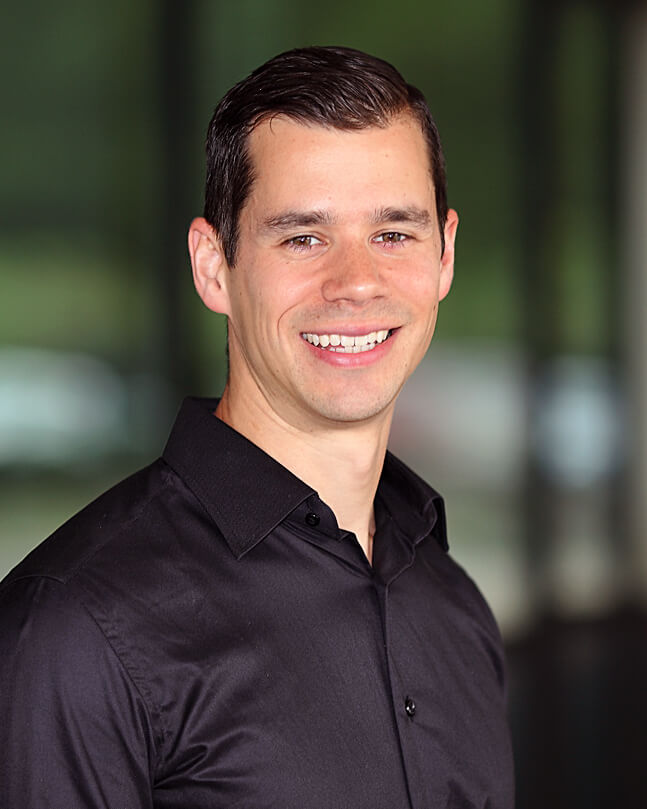Revolutionizing Biomass Processing: Unlocking the Potential of Liquid-Liquid Extraction (LLE) in Organic Chemical Recovery
March 2024
/Category:Biodiesel & Biochemical
Authors: Donald Glatz, Brendan Cross

Recently, a significant effort has been made to produce and recover valuable organic chemicals from biomass. The recovery process typically involves several steps, which vary depending on the specific biomass feedstock and the desired end products. A common step upstream of the recovery process is fermentation, where microorganisms transform biomass into valuable chemicals. After fermentation, the organic chemicals produced need to be recovered from the fermentation broth–a mixture containing low concentrations of the targeted chemicals, biomass, and water. Efficiently separating the water from the targeted chemicals presents a challenge because the produced organic chemicals often have higher boiling points than water, or are non-volatile, making traditional separation methods impractical. Removing the water by evaporation or distillation is not economical since the majority of the broth is water. To develop an efficient recovery process, Liquid-Liquid Extraction (LLE) is a promising option.
Liquid-Liquid Extraction (LLE) for Efficient Organic Chemical Recovery
While distillation is a widely used separation technique for recovering organic chemicals based on differences in boiling points, its limitations in energy consumption and potential chemical degradation make it less optimal compared to other methods. To address this, Liquid-Liquid Extraction (LLE), also known as Solvent Extraction (SX), emerges as a viable alternative. LLE involves the mass transfer of the desired compounds from the aqueous phase into an immiscible organic phase, typically via counter-current contacting of the two phases. This method is useful for separating organic acids and other compounds either directly from the whole broth or after pre-treating the broth to separate less desirable components like cell mass and lignin.
A few key advantages of LLE:
- Lower Operating Costs: When LLE is determined to be the optimal unit of operation, it offers cost advantages over conventional distillation, especially in processes that require one or more energy-intensive distillation steps. In such scenarios, less energy is required, reducing operational expenses and enhancing cost efficiency.
- Recovery of Higher Boiling Compounds: Liquid-liquid extraction efficiently recovers compounds with higher boiling points than water, making it ideal for processes where traditional distillation methods are impractical due to the need to boil off large amounts of water, which has an extremely high heat of vaporization.
- Extraction of Non-Volatile Components: Liquid-liquid extraction is effective in recovering non-volatile components like many hormones and nutraceuticals, which cannot be separated through vaporization. It provides a reliable solution for isolating these components, facilitating their utilization in various industrial processes.
- Separation of Heat-Sensitive Materials: Liquid-liquid extraction is essential for separating heat-sensitive materials such as antibiotics. Unlike distillation, which involves high temperatures, this method enables separation at ambient or lower temperatures, preserving the integrity and efficacy of heat-sensitive compounds.
- Efficient Separation of Close-Boiling Mixtures: Liquid-liquid extraction excels in separating close-boiling mixtures that challenge traditional distillation techniques. This is because LLE relies on differences in chemical structure as opposed to distillation, which employs differences in relative volatility to achieve a separation. Furthermore, by selecting an optimal solvent, the LLE process can be designed to be selective, resulting in more efficient downstream purification steps, if required.
Overall, LLE can offer a more efficient, cost-effective, and environmentally friendly approach to recovering organic chemicals from biomass reaction processes, like fermentation, making it a preferred choice for many industrial applications.
The KARR® Column: A Superior Extraction Column for Emulsifying Systems
Once LLE is determined to be the most economical separation method for recovering organic chemicals from fermentation broth, it is important to select the right type of extraction column based upon separation efficiency, energy consumption, cost, and throughput. Compared to other extraction technologies, agitated extraction columns offer the optimal solution due to their high efficiency and smaller footprint.
Koch Modular offers two types of agitated extraction columns: SCHEIBEL® and KARR®. When separating mixtures with a relatively high-density difference between the phases and high interfacial tension, a column with rotating internals, such as the SCHEIBEL column, is the best solution. However, fermentation broths often have lower density differences and low interfacial tension and thus are easily prone to emulsification, making the KARR column the superior method due to its reciprocating type agitation. In the KARR column, the reciprocating type agitation involves a plate stack that gently moves up and down versus a rotating impeller. By doing so, the KARR column provides uniform shear mixing across the cross-section as opposed to non-uniform shear mixing found in rotating internals. By introducing uniform shear mixing, the KARR column produces a more uniform dispersed phase particle size distribution. This type of mixing has been proven to be optimal for these systems via many different applications, whereby the tendency to emulsify can be significantly reduced and even eliminated.
Designing an Efficient LLE System
When considering the addition of an LLE system into your process, the following three steps are key for a successful design:
- Solvent Selection and Laboratory Testing: are necessary to generate the liquid-liquid equilibrium data and to evaluate the hydraulic behavior of the system. Based upon mixing and settling behavior, the selection of the KARR vs the SCHEIBEL column can often be made.
- Pilot Plant Testing: should be performed to generate data for accurate production equipment design. Koch Modular handles this at its pilot facility in Houston, Texas.
- Complete System Design: downstream distillation is usually required to recover the solvents for recycling and to selectively recover and purify the chemicals of interest. It is critical to have a good understanding of the composition of the LLE feed and the final compositions of both the extract and raffinate phases leaving the extraction column so that the downstream distillation columns can be designed accordingly.
Solving the Fermentation Process
In addressing the challenge of acetic acid recovery from a fermentation broth of waste wood material, a leading biorefinery developer sought Koch Modular's expertise. Having encountered emulsification issues and poor separation during pilot testing in a rotating disc contactor column, the client provided fermentation broth to Koch Modular for additional pilot testing.
Koch Modular successfully conducted pilot testing using a 1” diameter KARR column, achieving close to 99% extraction of acetic acid from the fermentation broth. Notably, the solvent-to-feed ratio was reduced from 2 (per the client's estimate) to 1.5. This efficient extraction process was pivotal, surpassing the client’s expected and targeted recovery of acetic acid from the fermentation broth.
The modular system designed by Koch Modular included the KARR column for extraction of acetic acid from the broth, a downstream raffinate stripping column, and a distillation column for generating acetic acid product and recycling the solvent back to the extraction step. The KARR column has a 22” diameter and reflected 484 times scale up from the 1” diameter column used during pilot testing.
In light of these achievements, the client progressed to the adoption of proven esterification technology for further product conversion. The esterification part of the plant transformed acetic acid into ethyl acetate, a valuable salable product and the chemical precursor crucial for the client's cellulosic ethanol production. This collaborative effort demonstrates the practical application of innovative solutions in addressing challenges associated with biorefinery processes.
Conclusion
The integration of LLE, especially with column designs like KARR, proves instrumental in addressing the complexities of biomass processing, offering economic viability, sustainability, and breakthroughs in organic chemical recovery. The acetic acid extraction case study exemplifies the successful application of LLE to mitigate unique separations challenges as well as emphasizing the critical steps required in designing an efficient LLE system, from solvent selection and laboratory testing to pilot plant testing and complete system design.
Authors

Chat with Don
Don Glatz is the Manager of Extraction Technology at Koch Modular. With a remarkable career spanning over 47 years, Don is an expert in evaluating, optimizing, scaling, and designing extraction processes. His profound knowledge and experience have been shared through numerous published papers and articles. Don holds a Bachelor's degree in Chemical Engineering from Rensselaer Polytechnic Institute, complemented by an MBA from Fairleigh Dickinson University. His invaluable contributions continue to shape the field of extraction technology.
Email: donald.glatz@kochmodular.com

Chat with Brendan
Brendan Cross is a Principal Extraction Engineer at Koch Modular that works in the Extraction Technology Group. Brendan is responsible for liquid-liquid extraction application evaluation, extraction process development, and pilot test design, extraction column design, and commissioning & process startup. He has been with Koch Modular for 15 years and also has substantial experience in distillation and process design. Brendan holds a BS in chemical engineering from Columbia University.
